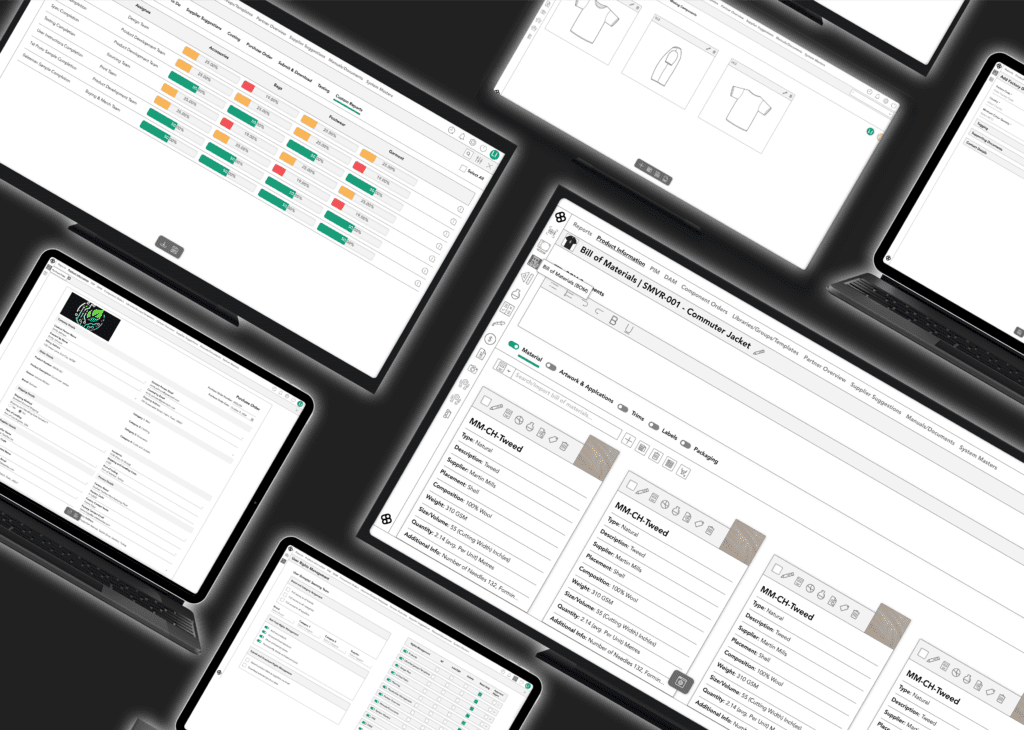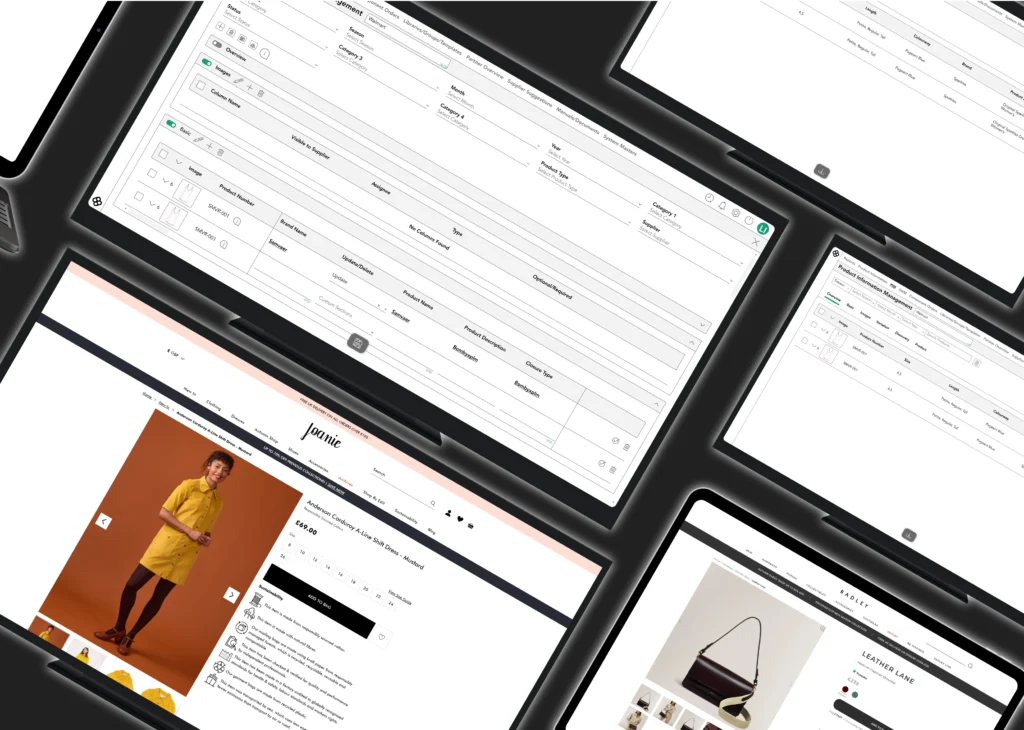Whats The Difference Between PIM & PLM Software?
How often are you advised to invest in Product Management Software to keep up with the industry? An ongoing discussion within Brands to uncover the best time and the best software to start from. A discussion that is quickly turning from a ‘want’ to a need’. According to McKinsey the fashion industry gained 21% in revenue between 2020-2021 with EBITA doubling from 6% to 12.3%.
At the time, the world was at its peak suffering from COVID-19, a global Pandemic. The overwhelming demand significantly commenced productivity and efficiency discussions through digitalising and utilising the software available. Fast-forward to 2023, despite financial recessions occurring around the world, the fashion industry is still growing, particularly the Luxury sector.
McKinsey Analysis forecasted during the year for a 5%-10% increase. This calls upon a greater demand for PLM & PIM software as Luxury brands face unique challenges in designing, producing, and managing their exclusive products due to high customer expectations. With the greatest challenge of Ethical and sustainable sourcing while trying to Reduce the Supply Chain Risks.
In the midst of growing challenges, the workforce of Brands and Suppliers is asking for seamless platforms to assist in daily operations. while customers demand a better Digital shopping experience. Key platforms in achieving these goals are both product lifecycle management (PLM) and product information management (PIM) software.
Decision-makers frequently struggle to discern the differences between PLM and PIM and determine their necessity. Within this conversation, we’ll explore crucial details to assist you in making the best decision for your business.
product lifecycle management definition
Product Lifecycle Management (PLM), is all about gathering and organising your product data from concept to complete production. A platform that integrates your whole supply chain to collaborate from a single location.
Create and recycle data continuously for enhanced productivity on each product. The whole point of PLM? Simply, to tidy up your internal information, make things run smoother, and speed up getting your products out there.
product information management definition
Product Information Management (PIM) is like the central hub for all your customer-relevant product data to be used for Marketing and Sales strategies. This version of data is what is seen by the end customer on digital sales platforms upon which they choose to make purchases.
The Whole point of PIM? As Brands have multiple channels of Sales, PIM essentially ensures the correct same data is delivered to all platforms ensuring consistency and customer trust.
do plm and pim have any similarities?
Although PIM and PLM software differ significantly, they also share some commonalities. Both serve as centralised storage for product information and data. They are both capable of integration with other software and processes within your tech infrastructure, thereby improving their functionality.
Additionally, they both contribute to improved collaboration, efficiency, and overall value within your business, facilitating quicker innovation. However, these shared traits mark the limit of similarities between PLM and PIM Software.
the difference between pim vs plm software
Role:
PLM: operates as an inward-facing software. It gathers and consolidates data from diverse internal sources and departments, ensuring that all your teams access and operate from a unified database. Within PLM, you’ll find data pertaining to the inception, design, development, and production stages of your products.
Essentially, the one location to create and maintain the Single Source of Truth of any data related to products and their Supply Chain.
PIM: serves as an outward-facing software. Dedicated to managing your customer-oriented data. It streamlines the transmission of product information from internal databases to your customers, ensuring a uniform product experience across all sales channels.
Within PIM, you’ll find details like product descriptions, specifications, sizes, stock levels, and Retail pricing including discounts or offers. Essentially, any product information your customers need to make a purchase.
Lifestyle Stages:
PLM: takes the initial lead. The concept starts from the very beginning of season planning, much before the products are designed or defined with precise data. A product’s journey within a PLM travels through concept, design, development, and manufacturing.
Bombyx PLM provides extended lifecycle management tools for a better-centralised experience, which can be tracked all the way to goods being delivered to the Brand’s distribution centers, including Purchase Order generating and tracking.
PIM: follows from PLM but a product’s lifecycle can start on PIM while it’s also ongoing on PLM. Once the products are finalised for market launch, PIM becomes active in overseeing their marketing and sales Strategy.
Brands will utilise PIM features of sourcing via integration or uploading formatted files and in some cases manually enter the data. The finalised data is distributed from PIM to E-commerce platforms where their life cycle ends at the forefront of customers’ view.

Software Users:
PLM: The user base tends to be much larger on PLM software as almost every product department requires access to add, update, and extract information. Core departments needing access are, Buying, Sourcing, Design, Product Development, and Costing.
Other departments may require limited or infrequent access, like logistics or warehousing teams, to plan ahead on transportation and stock control. Additionally, integrating suppliers into your PLM can provide foresight into potential supply chain issues that might impact your product lifecycle. However, PLM’s usefulness extends to Sales teams, offering historical perspectives on specific products, their costs and margins or markups achieved.
PIM: Unlike PLM, the user base for PIM is primarily focused on the Marketing and Sales department. However, these teams do require data from PLM users such as Description, SKUs, Spec, and technical details like Fibre Composition. Nevertheless, those users are not required to onboard a PIM, as explained above, PIM features have the capability to automatically call upon data from other integrated software including a PLM.

Integration & Compatibility:
PLM: The functionalities of PLM predominantly revolve around design and manufacturing, reflecting its integration preferences. PLM allows you to import CSV and XLS files as well as use APIs to connect seamlessly with CAD programs, Adobe Illustrator, and various other design software.
PLM commonly interfaces with ERP and PDM software for receiving and sending data as the product proceeds along its life cycle. Even a PIM can be integrated, as your PLM is most likely to have correct updated product data as the Tech Pack is constantly updated Vs any other software within your enterprise. Its role involves orchestrating these diverse programs, ensuring a comprehensive repository of historical data for your reference.
PIM: Likewise, PIM software has the same capabilities of integration including the use of CSV files, and XLS files as well as the use of APIs for importing data. PIM is then able to connect with Digital Sales platforms like your website and even third parties like Amazon, and Shopify Store. A greater explanation of What Does A PIM Do is provided with a graph showing the import and export methods of Data through PIM.

Summary:
PLM: significantly aids in expediting product launches while maintaining superior quality. Using diverse features and functions enhances collaboration and internal efficiencies during product development. By offering a comprehensive view of the entire lifecycle, PLM ensures all involved departments have clear insights into the product’s progress.
Additionally, it facilitates standardisation and automation of Bills of Materials, Testing, Inspections, etc, enabling improved product costing and effective management to achieve desired margins.
PIM: PIM is instrumental in empowering your team to deliver compelling product experiences that elevate the customer’s purchase. Resulting in enhanced sales, broader market outreach, and fewer product returns. This evolves the customer preferences, fostering brand loyalty, and expanding market share through extensive multiple sales channels.
Moreover, PIM streamlines operations by automating tasks like localisation and syndication, reducing the chance of inconsistent or inaccurate information in customer-facing materials.
plm vs pim - which one to get?
In essence, the debate between PLM versus PIM isn’t really a debate at all. They serve distinct purposes, and most businesses involved in both production and sales will probably require both software. Particularly larger entities or those with extensive product lines.
These two software complement each other effectively: PLM focuses on product development, while PIM handles product experience, sales, and marketing. Together, they optimise the entire product lifecycle, from concept to customer, resulting in an enhanced experience for both your internal teams and your customers.
PLM would be a better place to start as the core product data is created and kept up to date on this Software. PIM can be introduced once the PLM is fully functional, connecting them together to create a powerhouse in your business.
For smaller E-commerce businesses that tend to be not involved in product development and are primarily focused on selling products readily available, a solely PIM investment would be more compelling.
Good news! Bombiix provides both PLM & PIM solutions crafted for effortless integration and customisable to suit your specific business requirements. You have the capability to seamlessly exchange information between your PLM and PIM software.
Looking for a stress-free streamlined digital transformation or want to learn more about the roles of PLM & PIM? Book a demo with Bombiix and we’ll provide all the answers to your questions.

